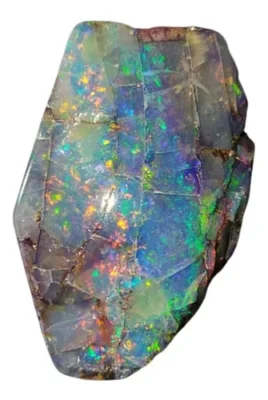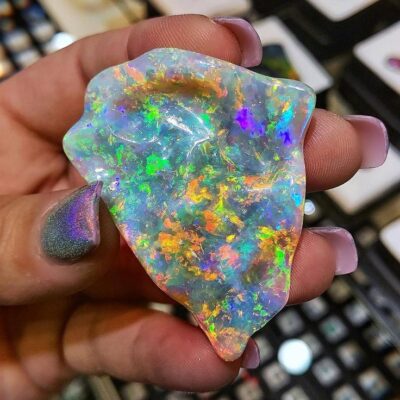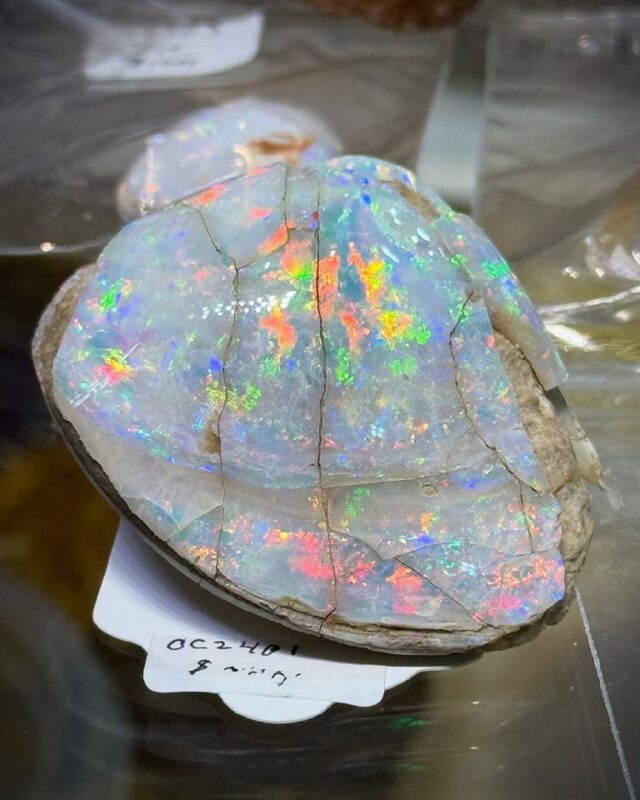
The Formation of Opalized Clam Shells
What is Opalization?
Opalization is a rare geological process where minerals, particularly opal, replace the organic material of a fossil over time. The result is a striking transformation, where the original structure, such as a clam shell, is preserved and enhanced by the vibrant colors and patterns of opal. This process occurs when the clam shell is buried in an environment with high silica content, allowing opal to form and eventually replace the calcium carbonate of the shell.
The Rare Occurrence of Opalized Fossils
Opalized fossils are among the rarest of all fossil finds. The specific conditions required for opalization—such as the right chemical composition, temperature, and pressure—make these fossils extremely difficult to come by. The vibrant, colorful patterns that opal imparts to the fossil are what make these pieces so highly prized by collectors and scientists alike. The opalized clam shell is a rare and extraordinary specimen that showcases this incredible natural process in its most dazzling form.
The Clam Shell’s Preservation
The opalized clam shell’s incredible preservation is a testament to the unique conditions under which it was formed. The fact that the shell remains mostly intact, covered in opal, is a remarkable feat in itself. Over millions of years, the shell would have undergone gradual mineral replacement, and yet it retained its original shape and structure. This remarkable preservation allows researchers to study not only the opalization process but also the creature itself, providing valuable insights into ancient marine life.

The Vibrancy of the Opal Display
A Spectrum of Colors
One of the most captivating features of the opalized clam shell is the dazzling display of colors that cover its surface. Opals are known for their ability to reflect light in a variety of hues, and this clam shell is no exception. The opalization has created a striking kaleidoscope of colors, including blues, greens, reds, and purples, making it an extraordinary natural gemstone. The interplay of these colors is not just visually stunning but also highlights the opal’s ability to mimic the colors of a rainbow, creating a spectacle that is both mesmerizing and rare.
The Role of Light in Opal’s Beauty
Opal’s signature flashing colors are dependent on the light and angle from which it is viewed. This dynamic feature gives the opalized clam shell an ever-changing appearance, which makes it all the more enchanting. Whether under bright sunlight or dim indoor lighting, the shell’s opal coating will exhibit different hues, adding a layer of depth and intrigue to its beauty. The mesmerizing colors are a result of microscopic silica spheres in the opal that diffract light, giving the shell its signature play of color.
A Natural Work of Art
The opalized clam shell can be considered a natural work of art. Its unique patterns, created by the opal’s play of color, are unlike anything man-made. Every opalized shell is a one-of-a-kind creation, with its own specific color combinations and patterns. These natural masterpieces, like the vibrant opalized clam shell, demonstrate the breathtaking creativity of nature.

See more: Masada: The Beauty and History of Israel’s Iconic Landmark
The Significance of the Opalized Clam Shell
A Rare and Valuable Find
The opalized clam shell is not just a beautiful specimen; it is a rare and valuable find. Fossils, in general, are prized for their ability to provide insight into past ecosystems and life forms, but an opalized fossil takes this a step further by offering a glimpse into an even rarer geological process. The rarity of opalized fossils makes them highly sought after by collectors and paleontologists alike, as they offer both scientific and aesthetic value.
Insights into Ancient Marine Life
The opalized clam shell also holds significant value in the study of ancient marine life. By analyzing the structure of the shell and the surrounding opal, scientists can learn more about the species of clam, its habitat, and the environmental conditions that led to its fossilization. This kind of research helps scientists piece together the history of marine ecosystems, providing a deeper understanding of how life on Earth evolved over millions of years.
A Fascinating Display of Natural Wonder
Finally, the opalized clam shell serves as a fascinating display of the wonder and beauty of the natural world. From its opalized surface to its near-perfect preservation, this remarkable fossil offers a glimpse into the wonders of geology and paleontology. It’s a testament to the power of nature, capable of creating treasures of unparalleled beauty over millions of years.

Conclusion
The vibrant opalized clam shell is a rare and awe-inspiring discovery that showcases the incredible forces of nature at work. Its striking colors, detailed preservation, and the fascinating process of opalization make it a true geological marvel. Whether you are a collector, a paleontologist, or simply someone who appreciates the beauty of the natural world, the opalized clam shell is a reminder of the extraordinary treasures that nature has hidden beneath the Earth’s surface for millennia.


CÁC TIN KHÁC
Mary Walton: The Forgotten Inventor Who Helped Clean Up America’s Cities
Tomb of Queen Nefertari in the Valley of the Queens, Egypt
Discover the Hypostyle Hall of the Temple of Hathor at Dendera
Venus de Losange: Unveiling the Mystery of a 20,000-Year-Old Paleolithic Icon